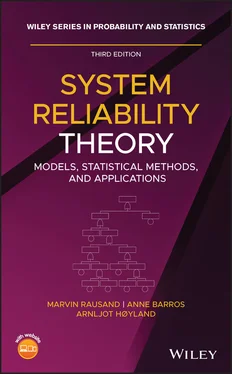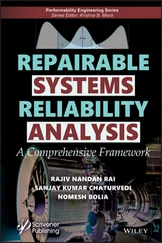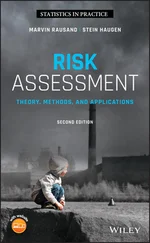803 800
804 801
805 802
806 803
807 804
808 805
809 806
810 807
811 808
812 809
813 810
814 811
815 812
816 813
817 1
818 2
819 3
820 4
821 5
822 6
823 7
824 8
825 9
826 10
827 11
828 12
829 13
830 14
831 15
Wiley Series in Probability and Statistics
Established by WALTER A. SHEWHART and SAMUEL S. WILKS
Editors
David J. Balding, Noel A.C. Cressie, Garrett M. Fitzmaurice, Harvey Goldstein, Geert Molenberghs, David W. Scott, Adrian F.M. Smith, and Ruey S. Tsay
Editors Emeriti
Vic Barnett, Ralph A. Bradley, J. Stuart Hunter, J.B. Kadane, David G. Kendall, and Jozef L. Teugels
A complete list of the titles in this series appears at the end of this volume.
System Reliability Theory
Models, Statistical Methods, and Applications
Third Edition
Marvin Rausand Norwegian University of Science & Technology Trondheim, Norway
Anne Barros CentraleSupélec, Paris-Saclay University Paris, France
Arnljot Høyland† Norwegian University of Science & Technology Trondheim, Norway

This third edition first published 2021
© 2021 John Wiley & Sons, Inc.
Edition History
John Wiley & Sons, Inc. (1e, 1994)
John Wiley & Sons, Inc. (2e, 2004)
All rights reserved. No part of this publication may be reproduced, stored in a retrieval system, or transmitted, in any form or by any means, electronic, mechanical, photocopying, recording or otherwise, except as permitted by law. Advice on how to obtain permission to reuse material from this title is available at http://www.wiley.com/go/permissions.
The right of Marvin Rausand, Anne Barros, and Arnljot Høyland to be identified as the authors of this work has been asserted in accordance with law.
Registered Office
John Wiley & Sons, Inc., 111 River Street, Hoboken, NJ 07030, USA
Editorial Office
111 River Street, Hoboken, NJ 07030, USA
For details of our global editorial offices, customer services, and more information about Wiley products visit us at www.wiley.com.
Wiley also publishes its books in a variety of electronic formats and by print‐on‐demand. Some content that appears in standard print versions of this book may not be available in other formats.
Limit of Liability/Disclaimer of Warranty
While the publisher and authors have used their best efforts in preparing this work, they make no representations or warranties with respect to the accuracy or completeness of the contents of this work and specifically disclaim all warranties, including without limitation any implied warranties of merchantability or fitness for a particular purpose. No warranty may be created or extended by sales representatives, written sales materials or promotional statements for this work. The fact that an organization, website, or product is referred to in this work as a citation and/or potential source of further information does not mean that the publisher and authors endorse the information or services the organization, website, or product may provide or recommendations it may make. This work is sold with the understanding that the publisher is not engaged in rendering professional services. The advice and strategies contained herein may not be suitable for your situation. You should consult with a specialist where appropriate. Further, readers should be aware that websites listed in this work may have changed or disappeared between when this work was written and when it is read. Neither the publisher nor authors shall be liable for any loss of profit or any other commercial damages, including but not limited to special, incidental, consequential, or other damages.
Library of Congress Cataloging‐in‐Publication Data
Names: Rausand, Marvin, author. | Barros, Anne, author. | Høyland, Arnljot,
1924‐ author.
Title: System reliability theory : models, statistical methods, and
applications / Marvin Rausand, Norwegian University of Science &
Technology, Trondheim, Norway, Anne Barros, CentraleSupélec, Paris‐Saclay University,
Paris, France, Arnljot Høyland, Norwegian
University of Science & Technology, Trondheim, Norway.
Description: Third edition. | Hoboken, NJ : John Wiley & Sons, Inc., 2021.
| Series: Wiley series in probability and statistics | Includes
bibliographical references and index.
Identifiers: LCCN 2020016182 (print) | LCCN 2020016183 (ebook) | ISBN
9781119373520 (cloth) | ISBN 9781119374015 (adobe pdf) | ISBN
9781119373957 (epub)
Subjects: LCSH: Reliability (Engineering)–Statistical methods.
Classification: LCC TA169 .H68 2021 (print) | LCC TA169 (ebook) | DDC
620/.00452–dc23
LC record available at https://lccn.loc.gov/2020016182
LC ebook record available at https://lccn.loc.gov/2020016183
Cover Design: Wiley
Cover Images: System reliability theory Courtesy of Marvin Rausand,
Abstract purple and pink polygonal © Tuomas Lehtinen/Getty Images
To Hella; Guro and Idunn; and Emil and Tiril
To: Nicolas; Penelope; and Garance
This book provides a basic, but rather comprehensive introduction to system reliability theory and the main methods used in reliability analyses. System reliability theory is used in many application areas. Some of these are illustrated in the book as examples and problems.
Main Changes from the Second Edition
Readers who are familiar with the second edition (Rausand and Høyland 2004) will find that the third edition is a major update and that most chapters have been rewritten. The most significant changes include:
A new Chapter 2defining the study object and its functions and operating context is included. System modeling by reliability block diagrams is introduced and the concept of complexity is discussed.
A new Chapter 3defining and discussing the concepts of failure and fault, together with several associated concepts is added. Two failure analysis techniques are presented.
New component importance metrics are included.
The treatment of dependent failures is significantly extended.
Section 8.8 on complex systems in the second edition is removed from the chapter on Markov analysis where several new models are added.
A new Chapter 2on preventive maintenance is added. This chapter merges aspects from the previous edition with new models and methods. The presentation is supplemented by Python scripts that are found on the book companion site.
Chapters 11and 13in the second edition on life data analysis and Bayesian reliability analysis are totally rewritten. The statistical program system R is extensively used in the presentation.
Chapter 12in the second edition on accelerated testing has been removed, but parts of the chapter are moved to the chapter on reliability data analysis.
The end of chapter problems have been revised and new problems are added.
Most of the appendices are removed. The content is partly integrated in the text and partly obsolete because of the use of R.
An author index is provided.
Supplementary Information on the Internet
An immense amount of relevant information is today available on the Internet, and many of the topics in this book may be found as books, reports, lecture notes, or slides written by lecturers from many different universities. The quality of this information is varying and ranging from very high to rather low, the terminology is often not consistent, and it may sometimes be a challenge to read some of these Internet resources. The reader is encouraged to search the Internet for alternative presentations and compare with the book. This way, new ideas and increased insight may spring up.
Читать дальше













